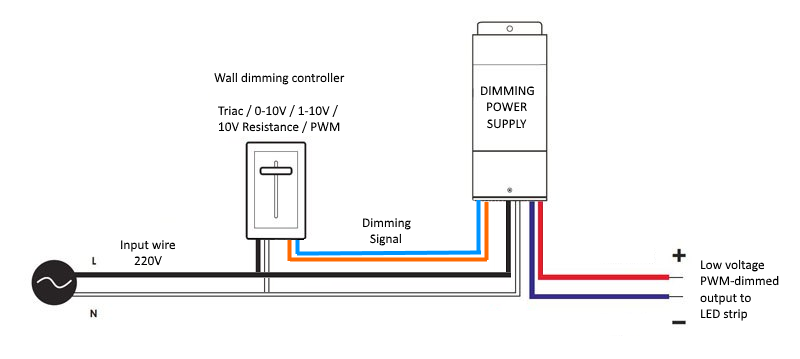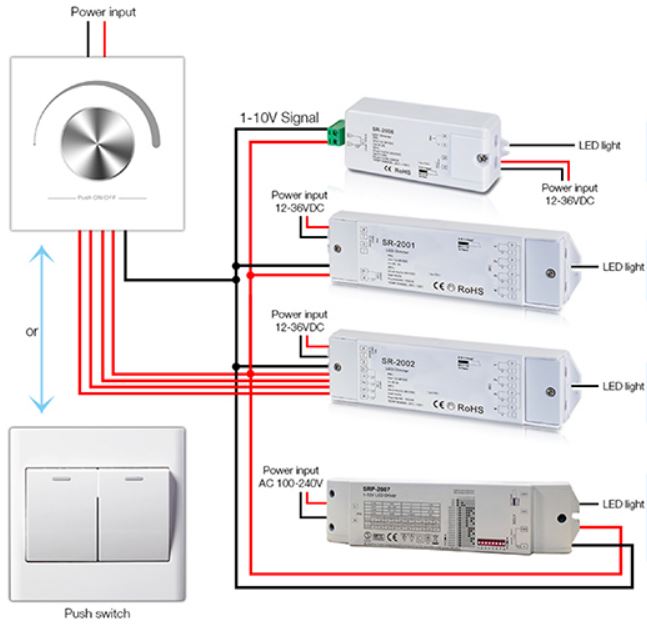Many people seem unaware that 220V and 12V LED Neon Flex and LED flexible strips can be dimmed. Dimming a 220V incandescent, CFC or halogen lamp was simple : reduce the input AC voltage and the light would dim, generally linearly. As a general rule, LED luminaires can’t be dimmed in this way, and there are two main reasons behind this.
Firstly: LED bulbs or chips operate at what is known as a forward voltage – usually around 4V (give or take). At a lower voltage the LED will be dimmer, at a higher voltage the LED is likely to suffer permanent failure. The LED will not dim linearly since the relationship between the voltage and the amperage of an LED is an exponential curve. As the voltage increases, the amperage increases exponentially which means the brightness increases exponentially. Light dimming must be linear for an acceptable user experience.Equally problematic, is that the LED has a minimum voltage before it “turns on” – meaning it is not possible to use voltage regulation to control the brightness of an LED from 0% to 100% brightness.
Secondly: Most LED luminaires operate at a low voltage, and operate behind a power supply. The power supply will take a 220V AC input and deliver for example, a 12V output. If the input drops to 150V AC the output will remain a constant 12V. So no dimming will occur. Many power supplies have under-voltage protection so that if the input voltage drops below 110V the power supply will not deliver any output voltage. For input voltages under 110V AC there is no output voltage, for input voltages between 110V AC and around 250V AC the output voltage will be 12V and for any input voltage over 250V AC there will again be no output voltage. This is true for most non-dimming switching power supplies, or at least the better quality ones.
So how can you effectively dim an LED?
The only effective way of dimming an LED is via pulse width modulation (PWM) where the input voltage to an LED is turned on and off rapidly, in a sequence. The voltage is either on or off, nothing in-between. If the on and off pulses are equal in time, the LED will be at 50% brightness. If the on pulses are twice as long as the off pulses, the LED will be at 75% brightness.

As can be seen by the diagram above, the sequence of on and off pulses determine the apparent brightness of the LED. I say apparent brightness, since that is how the human eye will perceive it. The PWM pulses are consistent – if they were not consistent in their on and off durations, the LED would appear to flicker.
There are really only two ways of delivering PWM signals to an LED:
a. Via a dimming power supply
b. Via a dimming controller
A dimming power supply is a regular switching power supply with a built-in dimming controller. The dimming power supply will accept a dimming input from a dimming switch of some kind, and convert it to a PWM signal. As an example, a 12V dimming power supply will generate a sequence of 12v / 0V PWM signals. The diagram below shows a dimmable power supply receiving a dimming signal from a dimming switch which will pass a signal to the power supply, which in turn will send a PWM signal to the LED.

A dimming controller is installed in conjunction with a switching power supply, taking for example a 12V input from the power supply, as well as taking input from some form of dimming control or remote control, and output a sequence of 12v / 0V PWM signals.

The example above shows a 0-10V or 1-10V dimming controller, receiving an input signal from a dimmer unit, and input from a power supply. The dimming controller sends all voltage to the LED strip light – this will be a PWM signal.
Which LED luminaires cannot be dimmed?
220V luminaires which have a built-in power supply, for example 220V down light bulbs, cannot be dimmed, unless the luminaire was specifically designed to accept a dimming input signal.
Dimming protocols
There are a number of dimming protocols and it is essential that you plan well when deciding which protocol to use: 0-10V, 1-10V, Triac, DALI, 10V PWM, resistance, DMX. You need to match the protocol of the dimmer unit (the dimmer switch unit in the wall for example) with the protocol of the dimming power supply or the dimming controller. As an example, you cannot use a DALI dimmer unit with a Triac dimming controller. Triac and resistance dimmers are possibly the simplest to understand and install.

A DALI dimmer unit will send its dimming signal to a DALI control bus which in turn will send its signal to a DALI-compliant dimming controller or a DALI-compliant dimming power supply. As you can see in the diagram below, a DALI system is complex and is generally used in large, commercial installations where entire buildings need to have their lighting controlled.

LUMUL sells the Mean Well ELG range of dimming power supplies, which support :
i. 3-in-1 dimming (0-10V, 10V PWM and resistance)
ii. DALI dimming
iii. Smart timer dimming
LUMUL also sells a range of controllers, both RGB and single colour dimming controllers. We offer controllers which accept DMX inputs, which act as DMX masters, accept RF inputs from remote controls, inputs from SmartPhone or tablet applications, which accept DALI inputs but equally, which generate DALI signals, and many which dim LEDs directly via a PWM signal.
Call us on 083-349-8453 or email us on enquiries@lumul.co.za to discuss how best to dim your LED installation.
